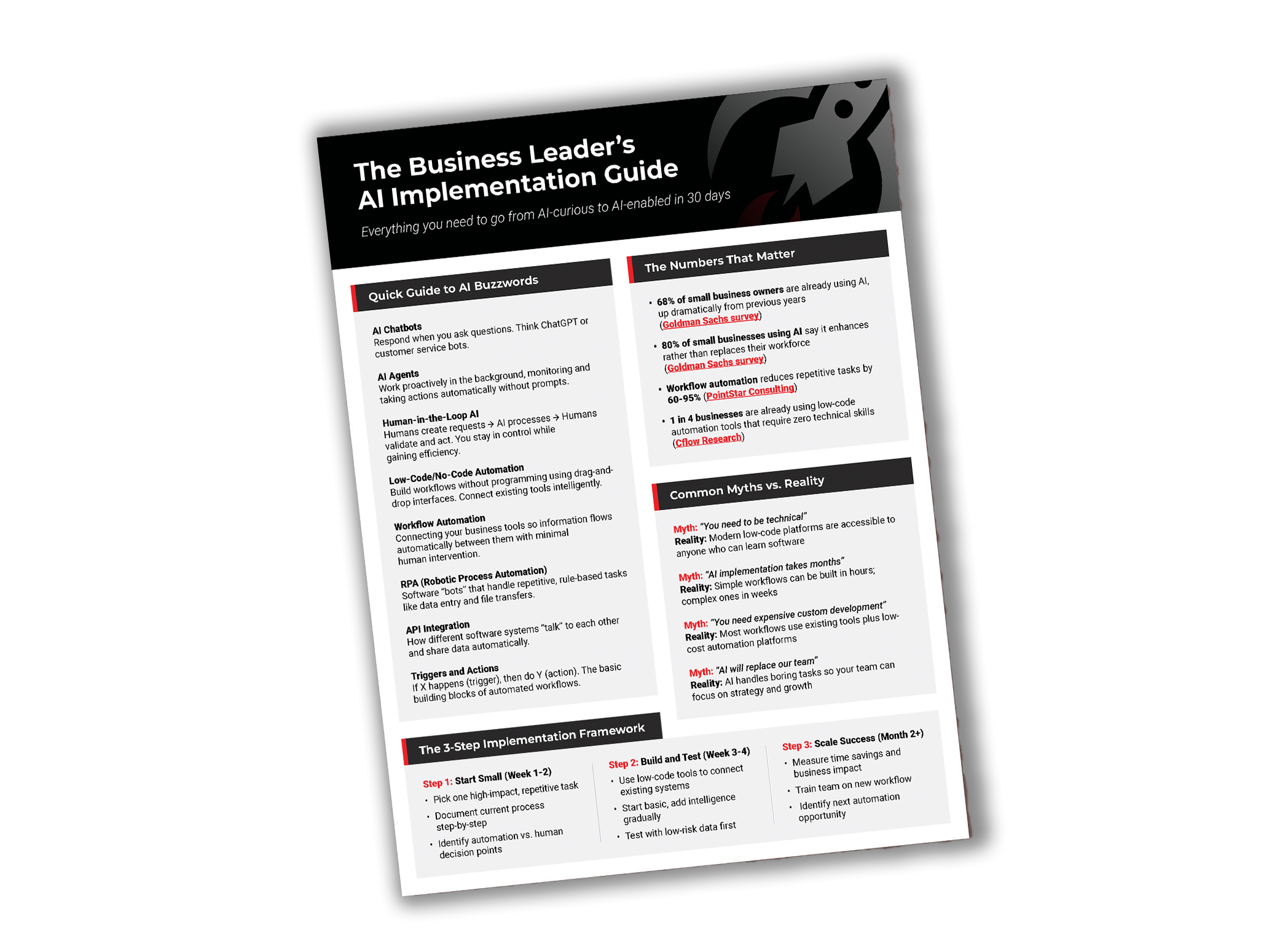"We know we should be doing something with AI, but we don't know where to start."
This is where most business leaders are right now: Aware of AI and its potential, but unclear on the specifics and unsure of the results.
It makes sense. Somewhere north of 80% of AI initiatives fail. Leaders don't want to lose their company millions or waste time trying to implement something that won't pay off.
But you don't need to risk millions to see real results.
Forget the Hollywood AI scenarios. The AI transformation happening in 2025 isn't about robots taking over. It's about AI agents that work behind the scenes to eliminate the tedious stuff that bogs down your team.
Think of AI agents as the ultimate executive assistant for your entire operation. They don't just answer questions when you ask (that's a chatbot). They work proactively in the background to eliminate the repetitive tasks that slow you down.
Here's what this looks like in practice: Your project management tool automatically generates weekly status reports, identifies which projects are at risk, and sends personalized updates to stakeholders—all while you're focused on closing deals or developing strategy.
Most AI vendors are selling dreams of "end-to-end" automation that frankly aren't ready for prime time. The real value (and the proven ROI) comes from what's often called human-in-the-loop AI or "middle-to-middle" approaches.
The workflow: Human creates the request → AI agent processes and analyzes → Human validates and takes action.
This approach gives you the efficiency gains of automation while keeping humans in control of critical decisions. It's also where you can start seeing results immediately, not someday in the theoretical future.
Most small businesses are already using AI to make work better and faster. About 68% of small business owners say they are already using AI (Goldman Sachs survey), representing a dramatic jump from previous years. Counter to the narrative, most small businesses using AI, about 80%, said it is enhancing rather than replacing their workforce (Goldman Sachs survey).
The majority of SMBs still believe true workflow automation is out of their price range. Larger organizations claim to use automation at a rate of 40% versus only 25% for smaller organizations (Cflow Research). This isn't because small businesses can't benefit from automation. It's because they think it's too complex or expensive to get started.
Workflow automation can reduce repetitive tasks by 60-95% (PointStar Consulting), leading to time savings of up to 77% on routine activities (Kissflow). Even better news: there are a variety of low-code automation systems that require no technical expertise and minimal upfront investment. 1 in 4 businesses are using low-code automation tools that require zero technical skills (Cflow Research).
So how much is this going to cost you? Not as much as you think. In fact, you probably already have most if not all of tools you need.
Most growing businesses are sitting on automation opportunities using software they're already paying for. Here are the five most common places to start:
Your Asana or Monday.com can automatically track project health, identify bottlenecks, and send personalized updates to stakeholders—no more spending Friday afternoons writing status emails.
Automatically categorize support tickets by complexity, route simple questions to your knowledge base, and escalate urgent issues with full context to the right team member.
Connect your QuickBooks to automatically categorize expenses, flag items for approval, and route invoices through your approval workflow.
Your CRM can automatically score new leads based on criteria you define, send personalized follow-up sequences, and alert your sales team when someone's ready to buy.
Set up automatic monitoring to identify duplicate records, missing information, and inconsistencies across your systems before they cause problems.
Want the step-by-step playbook? Our free implementation guide walks you through exactly how to set up each of these workflows, including which tools to use and how to connect them together. You'll also get a 30-day action plan to go from AI-curious to AI-enabled without the overwhelm.

We've put together a quick and comprehensive guide to AI buzzwords, myths, realities, and advice. Find out which ordinary tasks could save your team extraordinary amounts of time starting next week.
Download NowMost business leaders know they should be leveraging AI, but they're not sure where they stand. The truth is, your readiness has less to do with your technical sophistication and more to do with three critical factors:
Data Quality: How organized and accessible is your business information? AI is only as good as the data it works with.
Process Maturity: Do you have documented workflows, or is everything still "tribal knowledge"? AI amplifies good processes and exposes bad ones.
Growth Mindset: Are you willing to experiment and iterate, or do you need everything to be perfect before you start?
If you have decent systems in place and the appetite to improve them, you're probably more ready than you think.
We're seeing this firsthand with our clients. The companies that start implementing AI workflows today aren't just gaining efficiency. They're building sustainable competitive advantages that become harder to replicate over time.
The development work that used to take months can now be completed in weeks when you combine skilled human expertise with AI-enhanced workflows. (We're not talking about replacing our team. We're talking about making them unstoppable)
The question isn't whether you'll eventually use AI agents in your business. It's whether you'll lead the transformation or scramble to catch up when your competitors start moving twice as fast.
Bottom line: You don't need to become a tech company to leverage these tools effectively. You just need to start thinking like one.

